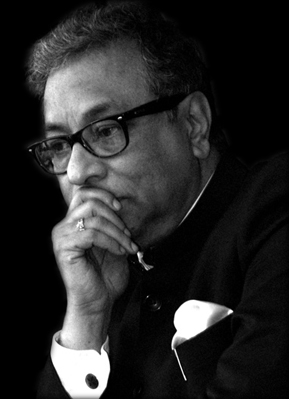It is a matter of concern that, till now, we have no comprehensive study or publication in English on Bamapada Bandyopadhyay (Banerjee) of Calcutta, whereas we have countess books, studies, videos and even a movie on his senior, Raja Ravi Varma of Travancore, Baroda, Bombay and Mysore. Like Varma, Bandyopadhyay was also a master of painting characters from the vast reservoir of Hindu mythology, in perfect life-like European style, that were reproduced in large numbers, mainly in Europe, and circulated widely in India. But Bandyoadhyay, who was immensely popular in the world of popular art of Bengal (and beyond) in the twentieth century, appears to have been completely overshadowed by Varma and later by others, like MV Dhurandhar.
It is in this background that I welcome Jyotirmoy Bhattacharya‘s well researched publication, entitled Bamapada Bandyopadhyay - The Lost Gem of Bengal Art, on behalf of art lovers everywhere. It will serve a great purpose by informing the large English-speaking audience about Bandyopadhyay and his art. Born in 1851, he witnessed one of the most exciting periods of a vibrantly renascent Bengal, and more importantly, the efflorescence of modern Indian art. This was the era when ‘native’ Indian artists were excelling in the media, materials and style of European artists and were being recognised by the imperial race, as worthy of note. In fact, one of the highlights of Bandyopadhyay’s career was the award he received in 1879 during the historic Calcutta Fine Art Exhibition for “The best figure subject in oil by a native of India”. The fact that Governor-General Lytton was the president of this exhibition and the Lieutenant Governor of Bengal, Sir Ashely Eden was its vice-president, gives us an idea of the very imperial character of this momentous exhibition.
What transformed Indian art beyond recognition was, of course, the arrival of the lithograph in the late 1870s, that could copy and reproduce a large number of almost exact visuals of the original. This led to an explosion of ‘high art’ being available to the gentry, at first, instead of a single masterpiece being confined with a single owner.
Several other awards and recognitions were bestowed on Bandyopadhyay around this time, as acknowledgement of his dexterity over the western artistic medium of oil painting. Unlike most of his peers, he was not centred on painting portraits of the elite, western or Indian, which assured them a position in high society and also handsome remuneration. He did a few, of course, like that of Edward VII, later to become King-Emperor of India, which, again, brought him honours. He was a prolific traveller and stayed for brief intervals at Allahabad, Lucknow, Lahore, Jaipur (where he was offered the post of principal of Jaipur Art College), Delhi, Agra, Mathura, Kashi and other cities. This broadened his vision and spread his fame, even as he made invaluable connections and friendships. He was, therefore, not a local Calcutta-centric painter —as is often believed.
What transformed Indian art beyond recognition was, of course, the arrival of the lithograph in the late 1870s, that could copy and reproduce a large number of almost exact visuals of the original. This led to an explosion of ‘high art’ being available to the gentry, at first, instead of a single masterpiece being confined with a single owner. With further improvements of technology, from more appealing chromolithographs and oleographs to the early offset prints, there was great demand for excellent subjects that would appeal to the ever-increasing clientele. This is where Ravi Varma came in with his depiction of characters and scenes from the epics, myths and legends of India. All of a sudden, Indians were able to ‘see’ personalities and deities that they had only heard of, till then, thanks to the emergence of high quantity and large-scale reprographic technologies that were hitherto available only in Europe. Though Bandyopadhyay followed Ravi Varma (he was only 3 years younger), he lived 26 years longer, and therefore, witnessed the revolutionary democratisation of Indian popular art. While Varma surely led the way in developing the extremely popular form of ‘calendar art’, that brought Hindu deities and mythology as well as iconic national leaders and luminaries to the masses, as no art form ever could, his follower, Bamapada Bandyoadhyay certainly did not receive his due recognition. Even Yogendra Bhargava and Hem Chander who further propagated Raja Ravi Varma’s legacy are better known than him.
I commend Jyotirmoy Bhattacharya for his labour and insights to project Bandyopadhyay and his art form — both in popular art and elsewhere and hope he will be able to place him on a better pedestal.
Foreword to 'Bamapada Banerjee - The Lost Gem of Bengal Art', by Jyotirmoy Bhattacharya, published by Alinda Publications
